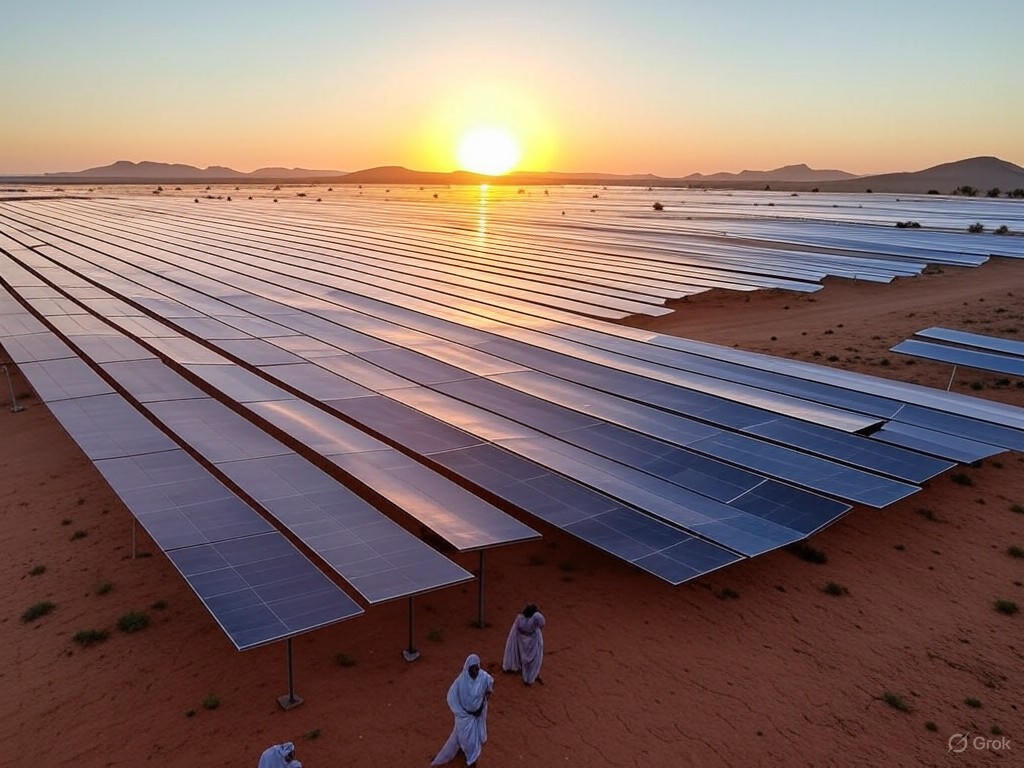India’s Solar Push: Leading the Global Renewable Race?
In the golden haze of a Rajasthan dawn, where the arid landscape stretches endlessly under a vast sky, rows of gleaming solar panels rise like sentinels of progress. Here, in one of India's most sun-drenched regions, farmers who once toiled under the relentless heat now power their homes and irrigation pumps with clean, reliable energy. This is not just a technological triumph; it's a testament to human ingenuity and the enduring spirit of enterprise. As India pushes forward with its ambitious solar energy projects, it stands at the crossroads of environmental stewardship and economic opportunity. Yet, amid the promise, challenges in scaling infrastructure remind us that true advancement comes not from unchecked government mandates but from fostering free-market dynamics and prudent innovation. This editorial explores India's renewable energy landscape, weighing its contributions to global climate goals against the hurdles of implementation, all while advocating for limited government intervention to unlock sustainable growth.
The Rise of Solar Energy in India: A Narrative of Ambition and Opportunity
India's journey into solar energy is a vivid story of transformation, rooted in the country's vast geographical advantages and growing technological prowess. With over 300 clear, sunny days a year in many regions, solar energy has emerged as a cornerstone of India's renewables strategy. The government's National Solar Mission, launched in 2010, aimed to achieve 100 gigawatts (GW) of solar capacity by 2022—a target largely met, with installations surpassing 60 GW and eyes now set on 500 GW by 2030 International Energy Agency (IEA). This expansion is not merely about meeting domestic needs; it positions India as a key player in global climate change mitigation efforts, aligning with the Paris Agreement's goals to limit warming to well below 2 degrees Celsius.
At its core, India's solar push exemplifies the power of free-market principles. Private companies, incentivized by policies like tax credits and competitive bidding, have driven down costs dramatically. For instance, solar panel prices have plummeted by over 80% in the past decade, thanks to global supply chains and entrepreneurial ventures Wall Street Journal. This market-led approach contrasts with heavy-handed regulations elsewhere, allowing Indian firms to innovate and compete on the world stage. Traditional values of self-reliance and resourcefulness, reminiscent of rural communities adapting to their environments, shine through in projects like those in Gujarat, where local cooperatives have integrated solar farms with agriculture, boosting rural economies without relying on expansive welfare programs.
Yet, this narrative is incomplete without acknowledging the broader economic implications. Solar energy investments are spurring job creation and industrial growth, with the sector projected to employ over 1 million people by 2025 SolarPower World. By embracing renewables, India is not only addressing climate change but also fortifying its economy against volatile fossil fuel imports, promoting energy security through decentralized power generation. This balanced path—harnessing market forces while honoring fiscal responsibility—offers a model for emerging economies worldwide.

The early morning light illuminates a sprawling solar farm in Rajasthan, symbolizing India's blend of ancient landscapes and modern innovation, where free-market initiatives are turning sunlight into economic opportunity.
Analyzing Challenges: Infrastructure Scaling and the Path to Sustainability
While India's solar ambitions are commendable, scaling infrastructure presents formidable challenges that demand a pragmatic, center-right lens. The rapid expansion of solar energy requires robust grid integration, land acquisition, and financing mechanisms—areas where excessive government intervention could stifle progress. For example, bureaucratic delays in obtaining approvals for transmission lines have hampered projects in states like Tamil Nadu, where solar potential is immense but regulatory hurdles persist IEEE Spectrum. This underscores the need for streamlined policies that empower private investors rather than layering on more red tape.
Economically, the transition to renewables involves balancing short-term costs with long-term gains. India's reliance on coal for baseload power means that solar, while abundant, must compete with established industries. Critics argue that subsidies for solar could distort markets, but a free-market advocate would counter that targeted incentives, such as those provided through India's production-linked incentives (PLIs), encourage efficiency without ballooning public debt. According to recent analyses, these measures have attracted over $10 billion in foreign investment for solar manufacturing, demonstrating how limited government support can catalyze private-sector innovation The Economic Times of India. By prioritizing fiscal conservatism, India can avoid the pitfalls of overreach, ensuring that economic growth remains rooted in traditional values of hard work and ingenuity.
Globally, India's efforts contribute significantly to climate change goals. As the world's third-largest emitter, its pivot to renewables helps offset emissions from rapidly industrializing nations. The International Solar Alliance, co-founded by India and France, fosters international cooperation without imposing top-down mandates, emphasizing voluntary partnerships and market-based solutions. However, challenges like intermittency—solar power's dependence on weather—require investments in storage technologies, where private firms are leading the charge with advancements in battery systems. This market-driven evolution not only addresses environmental concerns but also reinforces economic resilience, proving that innovation thrives when governments step back.

Workers meticulously check solar panel installations at a bustling construction site, highlighting the hands-on expertise and free-market entrepreneurship fueling India's renewable energy expansion amid infrastructural challenges.
Evidence and Implications: Balancing Growth with Prudent Policies
Evidence from various sources paints a clear picture of India's solar trajectory. Data from the IEA indicates that solar energy accounted for 45% of India's new power capacity additions in 2022, underscoring its role in diversifying the energy mix and reducing dependence on imports International Energy Agency (IEA). Economically, this shift has lowered energy costs for consumers and businesses, with studies showing a 20–30% reduction in electricity expenses in solar-rich regions Wall Street Journal. Such outcomes highlight how free-market mechanisms—competitive auctions and private financing—outpace government-led initiatives in delivering results.
Yet, the challenges are real. Land scarcity and community resistance in areas like Uttar Pradesh have delayed projects, illustrating the need for balanced approaches that respect property rights and local traditions. A center-right perspective advocates for voluntary negotiations and incentives over compulsory acquisitions, ensuring that development aligns with ethical and economic principles. As IEEE Spectrum notes, advancements in modular solar technology could mitigate these issues by allowing smaller, community-based installations that integrate seamlessly with existing infrastructures.
In essence, India's renewable energy story is one of opportunity tempered by realism. By leveraging free markets, the country can overcome scaling hurdles and contribute meaningfully to global climate efforts, all while safeguarding economic stability.
Conclusion: Forging a Brighter Future Through Innovation and Restraint
As the sun sets on India's solar fields, casting long shadows over a landscape of possibility, we are reminded that true progress lies in the intersection of vision and practicality. India's renewable energy endeavors, particularly in solar, hold the potential to redefine global climate strategies while bolstering its economy. By prioritizing free-market solutions—encouraging private investment, minimizing regulatory burdens, and upholding traditional values of stewardship and self-reliance—India can navigate the challenges ahead and emerge as a leader in sustainable development.
This path demands optimism and resolve, not utopian ideals. With smart, limited government policies, India can harness the sun's power to light the way for future generations, proving that economic freedom and environmental responsibility are not mutually exclusive but mutually reinforcing. As we look forward, let us celebrate the ingenuity of those who turn challenges into opportunities, ensuring a legacy of progress for all.

